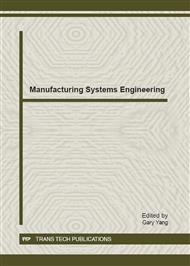[1]
Yongxin Yin, Ming Yang, Zicai Wang, Research on Control Method for Lateral Thrust Based on Interceptor in Aerosphere, IMACS Multiconference on Computational Engineering in Systems Applications, Beijing, China, October 2006, pp.713-716.
DOI: 10.1109/cesa.2006.4281745
Google Scholar
[2]
Kienitz K H, Bals J, Pulse modulation for attitude control with thrusters subject to switching restrictions, Aerospace Science and Technology, No. 9, 2005, pp.635-640.
DOI: 10.1016/j.ast.2005.06.006
Google Scholar
[3]
Wenlong Song, Yaqiu Liu, Qinglei Hu, Spacecraft Vibration Suppression During Attitude Maneuver Using PWPF Modulated Input Component Commands, Proceedings of the IEEE International Conference on Mechatronics & Automation Niagara Falls, Canada, July 2005, pp.493-498.
DOI: 10.1109/icma.2005.1626597
Google Scholar
[4]
Wang Qing, Yang Baoqing, Ma Kemao, PWPF Optimizing Design and Its Application Research to Terminal Guidance of Kenetic Killing Vehicle, Journal of Astronautics, Vol. 26, No. 5, September 2005, pp.576-580. (in Chinese).
Google Scholar
[5]
Liaoni Wu, Yimin Huang, ChengLong He, Lateral-Direction Control via Reaction Control System, 2009 International Asia Conference on Informatics in Control, Bangkok, February 2009, pp.52-56.
DOI: 10.1109/car.2009.62
Google Scholar
[6]
Yongxin Yin, Ming Yang, Zicai Wang, Modeling and Simulation of the Interceptor by Combined Control of Lateral Thrust and Aerodynamic Force, Proceedings of the 6th World Congress on Intelligent Control and Automation, Dalian, China, June 2006, pp.1805-1809.
DOI: 10.1109/wcica.2006.1712665
Google Scholar
[7]
Wang Ting, Zhou Jun, Modeling and Simulation Research of PAC-3 Interceptor, Journal of System Simulation, Vol. 19, No. 20, October 2007, pp.4642-4645. (in Chinese).
Google Scholar
[8]
Menon P K, Iragavarapu V R, Adaptive Techniques for Multiple Actuator Blending, AIAA Guidance, Navigation and Control Conference, Boston, August 1998, pp.1-12.
DOI: 10.2514/6.1998-4494
Google Scholar
[9]
Sungyung Lim, Roberto Pileggi, Gregg Barton, MIMO Adaptive Bank-To-Steer Control Algorithms for Guided Re-entry Vehicles, AIAA Guidance Navigation and Control Conference and Exhibit, August 2007, Hilton Head, South Carolina, AIAA-2007-6431.
DOI: 10.2514/6.2007-6431
Google Scholar
[10]
McClelland R S, Spacecraft Attitude Control System Performance Using Pulse-Width Pulse-Frequency Modulated Thrusters, ADA-2918035, Monterey, March 1994, pp.1-102.
Google Scholar
[11]
Kevin Langone, Luis Bermudez, Impact of Thrust Allocation Strategy on Attitude Control Motor Jet Interaction Effects, 27th AIAA Applied Aerodynamics Conference, San Antonio, Texas, June 2009, AIAA-2009-3960.
DOI: 10.2514/6.2009-3960
Google Scholar
[12]
Buck N V, Minimum Vibration Maneuvers Using Input Shaping and Pulse-Width, Pulse-Frequency Modulated Thruster Control, ADA-3256153, Monterey, December 1996, pp.1-151.
Google Scholar


